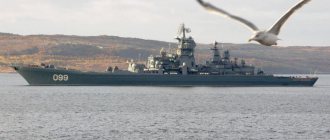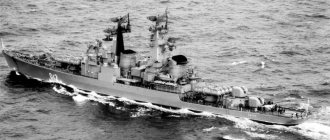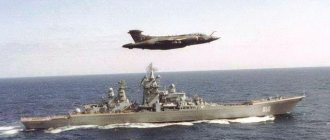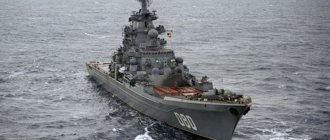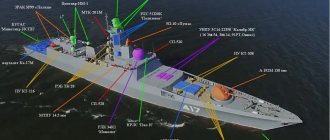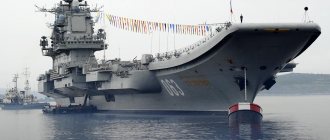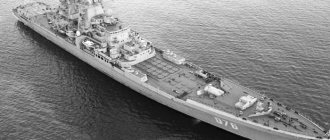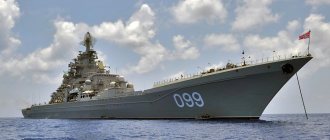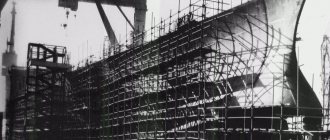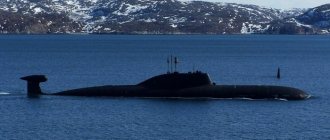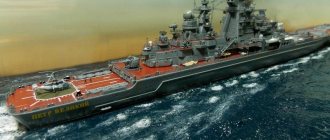09/02/2016 Category: Surface forces
- 2 Activity in modern conditions
- 3 Eyewitness impressions
- 4 Your visit
- 5 Contact numbers
The destroyer "Admiral Ushakov" was built according to project 956 "Sarych" and is part of the Northern Fleet of the Russian Federation.
Monument to the legendary Russian naval commander Admiral Fedor Ushakov
Construction history and service
Since 1972, destroyers of Project 956 have been built at shipyard No. 190 named after. A.A. Zhdanova. The ship, which until 2004 bore the name “Fearless,” was laid down at this plant in 1988. The ship was launched at the end of 1991.
In the winter of 1993 he was accepted into the fleet. During construction, from June 1993, he was part of the 13th brigade of ships under construction and repair at the Leningrad naval base. For the period of testing, it was assigned to the 76th brigade of missile ships of the 12th division of missile ships. He began his career in 1994, as part of the 56th destroyer brigade of the 7th operational squadron of the Northern Fleet. In the spring of 1995, the ship took an active part in anti-aircraft missile firing, together with the destroyer Rastoropny. In November of the same year, he carried out artillery firing under the supervision of the Russian Minister of Defense and the Commander-in-Chief of the Navy. At the end of 1995, together with the aircraft carrier cruiser Admiral Kuznetsov, he went through the Strait of Gibraltar to serve in the Mediterranean Sea.
Naval parade with the participation of aviation in Severomorsk on May 9, 2015 (Murmansk region)
In the period from August to September of the same year he was at the docks of the ship repair plant in Roslyakovo. In the spring of 1997, “Admiral Ushakov” made a short trip to sea to check its combat readiness, and in April it took part in Russian naval exercises. At the beginning of May 1998, the destroyer Besstrashny was included in the 43rd division of missile ships of the 7th operational squadron. When making a trip to sea in the summer of 1998, due to the shutdown of the ship's boiler-turbine installation, the destroyer Admiral Ushakov barely escaped from a raid on the rocks. After this accident, she was placed at the docks of the Murmansk shipyard for repairs.
Design and description of the ship
The ship "Admiral Ushakov" has a fully welded hull, an extended forecastle and reinforced anti-aircraft weapons. To protect important parts of the ship, traditional armor was made: anti-ballistic, anti-bullet and anti-fragmentation. For protection, mostly homogeneous armor was used.
Almost all of the ship's superstructures are made of aluminum-magnesium alloys. Most of the weapons are located in the stern and bow. Additional armor shields cover the engine room and ammunition magazines.
The cruiser has an elongated forecastle and a double bottom along the entire length of the vessel. The surface part consists of five decks (along the entire length of the hull). At the rear is a below-deck hangar that can accommodate three helicopters. A lifting mechanism is also constructed here and storage facilities are provided for materials needed for flights.
The main power plant of the cruiser was a mechanical two-shaft with two steam turbo-gear units and 6 boilers, which were located in eight adjacent compartments in the middle part of the ship's hull.
Activity in modern conditions
Today, Admiral Ushakov (Project 956 destroyer) performs the following combat missions:
- Defeat small ground targets, enemy personnel and technical forces
- Fire support for anti-aircraft and anti-boat defense of landing forces during landing at sea
- Destruction of enemy surface ships and their landing forces
Exercises on the destroyer SF "Admiral Ushakov"
In 2003, it left for repairs in Severodvinsk at the JSC CS "Zvezdochka". In March 2013, he successfully tested the actions of a single ship in the Barents Sea, at one of the Northern Fleet training grounds. At the same time, he interacted with a strategic nuclear submarine cruiser, naval aviation of the Northern Fleet and the mine sweeping group of the Kola Flotilla. At the end of August 2013, he completed exercises at the training grounds of the Barents and White Seas. In 2014, “Admiral Ushakov” celebrated its 20th anniversary since the ceremonial hoisting of the naval flag. During her service, the destroyer made two trips to the Atlantic and Mediterranean Sea. In 2015, the destroyer again took part in naval exercises in the Barents Sea, and also attended festive events dedicated to the Day of the Navy of the Russian Federation. In 2016, he took part in artillery firing in the Barents Sea, and also practiced combat with a mock enemy surface ship.
Destroyer Admiral Ushakov
Interesting Facts
It is noteworthy that the cruiser “Admiral Ushakov” (formerly “Kirov”) was mentioned more than once in popular culture. For example, in 1982 he appeared in the Soviet film “Case in Square 36-80”.
The Russian cruiser is also mentioned in the novel by writer Tom Clancy “The Red Storm Rises.” According to the author's idea, during the Third World War, the ship went out into the Atlantic to hunt for enemy ships and was sunk by a Norwegian submarine, which shot the cruiser with torpedoes.
The cruiser is also the focus of John Schettler's Kirov series of books. According to the story, in 2017-2021 the ship underwent a total modernization, for which three other cruisers were dismantled for spare parts. After that, she became the flagship of the Northern Fleet.
During the first missile firing, the Kirov, due to a mystical anomaly, finds itself in the past, namely in August 1941, where its appearance leads to a change in history. As a result, the cruiser begins a long journey through various times and alternative realities.
Also, the Soviet nuclear-powered cruiser Kirov appears in the film Threads, filmed for the BBC television company.
Eyewitness impressions
The destroyer "Admiral Ushakov" is part of the Northern Fleet, stationed at the naval base of the Closed Administrative Unit of Severomorsk, Murmansk Region. The ship is part of the 43rd Missile Ship Division. A ship is a combat unit that fights not only on the water (ships and submarines), but also destroys targets on the shore and in the air. The service, as eyewitnesses say, is standard for all warships. Sailors are on watch, on various duties, and are engaged in target practice. They go to sea for a week - 10 days. The destroyer's crew is about 350 employees. Most of them are contract soldiers. Reviews do not report hazing and hazing. On the contrary, they note a long vacation - 30 days of the main one, 15 - for service in the navy and another 15 - for the conditions of the Far North, BUT Severomorsk is located beyond the Arctic Circle. They talk about long acclimatization. The adaptation of the fighters is accompanied by colds that arise due to the cold winds and humidity of the North Sea.
Destroyer "Admiral Ushakov"
Both contract soldiers and conscripted sailors live in cabins with a shared bathroom. You should ask the employee about the date and time of the oath, as well as about dismissals and regulations on the use of mobile phones. Severomorsk is a closed settlement. To go to the oath, you need a pass (data is transferred to the sailor). As an option, a request is sent to the administration’s email address. Relatives receive the pass issued for the trip to the oath at the checkpoint. Pass to Severomorsk - at the ZATO checkpoint.
Armament
According to the plan, the cruiser "Admiral Ushakov" was supposed to strike enemy carrier groups, track down and destroy enemy submarines, and ensure the safety of its territories from air threats. Based on the assigned tasks, the ship received a lot of different weapons.
The main strike armament is represented by the Granit system, an anti-ship missile system located in the bow. It consists of twenty missiles, the maximum flight range of which reaches 550 km. The warhead of the missiles is nuclear, the warhead weighs 500 kg.
The ship's anti-aircraft armament is the Fort missile system. The cruiser is equipped with twelve drum installations with eight missiles each.
In addition to air targets, the Admiral Ushakov is capable of hitting enemy ships up to the destroyer class.
The ship's anti-submarine equipment includes the Metel missile system - 10 missile-torpedoes, the firing range of which reaches 50 km, and the depth of destruction - up to 500 m. In addition to the Metel, there are two five-tube torpedo tubes. There are also many small cannons and guns on the deck of the ship.
Battleship "Admiral Ushakov" in battle
"It was a victory of the spirit." Emperor Nicholas II
After entering service the following year, 1898, the coastal defense battleship Admiral Ushakov was annually included in the Artillery Training Detachment of the Baltic Fleet for three weeks to improve the training of artillerymen. Intensive training firing led to the fact that by the end of the 1904 campaign, during which 140 shells were fired from only 10" guns of the battleship, the total number of shots fired by the ship from main caliber guns reached 472 ( total training and combat
), which seriously affected the wear of gun barrels. The 120-mm rapid-fire guns found themselves in an even worse position, each of which already fired about 400 rounds.
At a Special Meeting held a few days before the capitulation of Port Arthur, a decision was made, and three days later, on December 14, 1904, the highest order was issued to send the first echelon of the 3rd Pacific Squadron to the Far East as part of the 1st Separate Detachment of Ships under the flag of Rear Admiral N.I. Nebogatov, whose departure from Libau was scheduled for January 15, 1905. The ships were prepared for sailing in the port of Emperor Alexander III, where, to speed up the work, which, at the request of the head of the Naval Ministry, Admiral F.K. Avelana, Emperor Nicholas II allowed to allocate 2,000,000.00 rubles, more than one and a half thousand government and private workers were collected and was brought into the dock, where the underwater part was cleaned and painted red, the sides, pipes and superstructures were covered with black paint . During the partial modernization, ten 37-mm single-barreled Hotchkiss guns were dismantled from Mars, which had lost some of its structures, and two Maxim machine guns with shields were placed instead; On the spardeck, instead of six 37-mm five-barreled Hotchkiss guns, four 47-mm Hotchkiss guns without shields were installed. Decorations were removed from the bow and stern, the bow and stern torpedo tubes were dismantled, and the torpedo launchers were removed from the steam boats. Thanks to these and a number of other measures, the construction overload of the battleship of 468 tons was reduced by about one hundred tons.
Along with GUKiS, the Obukhov plant produced six new 120-mm guns, two of which replaced the most worn ones on the Admiral Ushakov.
Four rangefinders were delivered to the battleship: two seized from the artillery class of the Baltic Fleet Artillery Training Detachment ( presumably one FA 2 and one
) and two latest modifications FA 3 (
production began in 1903
), as well as Belgian hand-held optical rangefinders produced by the Fabrique Nationale Herstal Liège (
a fact not mentioned in domestic sources
).
Guns of 120 mm and 10″ calibers received domestic optical sights of the Perepelkin system ( Lieutenant Ya. N. Perepelkin
).
Also on the Admiral Ushakov was installed a radiotelegraph of the Slaby-Arco system of the Telefunken society, developed by Dr. A. Slaby ( Adolf KH Slaby
) and his employee Count G. von Arco (
Georg Graf von Arco
).
Based on 80 shells per barrel, 320 10" shells were fired for the Admiral Ushakov ( including 92 armor-piercing, 198 high-explosive, 30 segment
), of which only 300 fit on the ship. 840 120-mm cartridges were also loaded on board (
210 per barrel
), of which 200 were with armor-piercing shells, 480 with high-explosive shells and 160 with segment shells.
Due to delays caused by workers' strikes, incited by agitators financed from abroad, as well as difficult weather conditions, the Separate Detachment did not leave until February 3, 1905.
During the artillery training that continued during the campaign, both barrel and caliber firing were carried out. On March 28, 1905, the first training squad shooting was carried out in the Gulf of Aden, four shots of high-explosive shells were fired from each main caliber gun. Two weeks later, the training was continued, and the battleship’s 10” guns fired four more shells each, and three days later, while loading coal, the ammunition expended in the training shooting was replenished from the transport ships accompanying the detachment. Thus, at the beginning of the Battle of Tsushima, the main caliber guns of the Admiral Ushakov fired about 504 shots. Looking ahead, we note that, as follows from the testimony of the senior navigator officer, Lieutenant E. A. Maksimov, on May 4, 14, 1905, the battleship fired about 200 more 10" shells, thus increasing their total number fired during operation, up to 704. According to the same information, about 400 shells were fired from 120-mm guns during the battle. Consequently, Admiral Ushakov entered the battle with two armored cruisers, having on average 176 rounds per main caliber gun. At the same time, according to MTK standards, the survivability of a 10" gun barrel was 200 combat shots per barrel ( which looks unreasonably optimistic against the background, for example, of a hundred combat shots for the American 10"/40 MkIII guns installed on armored cruisers of the " Tennessee"
), and 120 mm - 1,000. This could not but affect the wear of the barrels, which led to a loss of projectile speed and a change in its ballistic characteristics.
Operational wear was superimposed on design and manufacturing defects of the tools. Back in 1900, failures of the hydraulic drives of the tower units were observed on the Admiral Ushakov. In the 1901 campaign, wear and tear on the hydraulic drives of the 10th installations of the Admiral Ushakov became obvious; in the absence of servomotors for the lifting mechanisms, this led to the impossibility of accurately aiming the guns. Unfortunately, the overly “lightweight” guns and their machines had insufficient strength, which forced the powder charge to be reduced from 65.5 to 56 kg of smokeless powder, as a result of which the initial speed of the 225-kg projectile decreased from 778-792 to 695 m/s. In addition, the permitted elevation angle was limited, which, coupled with the reduced powder charge, led to a decrease in the actual firing range.
On April 26, 1905, Nebogatov’s ships joined Rozhdestvensky’s squadron, having covered about 12,000 miles in 83 days. In the daytime battle on May 14, 1905, “Admiral Ushakov” was at the end of the wake column of battleships, bringing up the rear of the 3rd armored detachment ( the flag of the junior flagship of Rear Admiral N.I. Nebogatov
).
During the Battle of Tsushima, the battleship, bypassing the damaged Emperor Alexander III, was hit on the starboard side by an 8" shell in the area of frame 15 near the waterline, as a result of which the entire bow compartment of the living deck was filled with water. The next shell, 6 caliber, hit the side at the waterline level, opposite the bow turret. As a result, three people were killed, one was mortally wounded, and four more were seriously injured. If the first hole was repaired with wood and sailor's bunks, then the second, with a diameter of about 90 cm, caused flooding of the entire bow compartment up to the 10th frame. It was not possible to close it without stopping the vehicles and stopping fire from the turret. The third shell (of unknown caliber), hitting the aft turret, shook it quite violently, leaving a deep dent in the vertical armor and showering the deck and spardeck wall with shrapnel. The fragments of one of the shells that exploded near the ship disabled the wireless telegraph and knocked down the gaff; crew losses during the day amounted to four dead and the same number wounded.
Having the entire bow compartment flooded, the battleship was heavily buried in its bow, so in the sea swell at maximum speed, the Ushakov could give no more than 10 knots of speed, as a result of which it lagged behind the other ships led by the Emperor Nicholas I, which developed a speed of 12-12 ,5 knots. At a meeting in the wardroom, it was unanimously decided to continue the journey to Vladivostok, trying to catch up with the formation that had gone ahead.
On the morning of May 15, 1905, detachments of the United Fleet, while drifting 26 miles south of Takeshima Island, carried out prize missions and monitored the ships of Nebogatov’s detachment that had surrendered. At 14:00, smoke was seen from the observation post on the Iwate mast on the south side. An hour later, based on clearly visible pipes, the ship was identified as a coastal defense battleship of the Admiral Senyavin type. At 15:24 from the flagship of the 2nd Battle Detachment, the cruiser Idzumo, to the cruiser Iwate ( flag of Rear Admiral Shimamura Hayao
) and "Yakumo" received orders to pursue the Russian battleship. Even before they rushed after him, the Admiral Ushakov turned back on course and began to go south.
The Japanese cruisers developed a speed of eighteen knots and after some time, 60 miles west of Oki Island, they again discovered the battleship. When the distance was reduced to eight miles, the Japanese, following a telegraph order from the Mikasa, tried to persuade the enemy ship to capitulate by raising at 17:10 ( time hereafter Japanese
) signal in English “Your admiral surrended, I would advise you to surrender,” which can be translated roughly as “Your admiral has surrendered, I advise you to surrender as well.” At 17:30, when the distance between the opponents was about five miles, the Japanese, convinced that the Russian battleship was not going to capitulate, opened fire on it. “Admiral Ushakov” also opened fire.
After the first four shots, the hydraulic horizontal guidance of the bow turret failed; they tried to rotate it manually, but since the turret rotated 180° in 20 minutes, firing from it became very rare. At the same time, the rear turret continued to fire. The battery's fire had to be stopped periodically because the battle distance exceeded the firing range of 120 mm guns. About ten minutes after the start of the battle, an 8" caliber shell hit the side opposite the bow turret and made a large hole at the waterline, as a result of which the existing stable list to starboard began to increase, which negatively affected the maximum elevation angle of the main caliber guns. A fatal role here was played by the fact that Ushakov had to fight on the right side, which had been damaged in the Battle of Tsushima.
At 17:45, the Japanese cruisers, which had increased their speed, completed an “all of a sudden” turn two points to the left, and in the bearing formation shortened the distance to the Ushakov. A 6" shell hitting the battery disabled the ship's right bow 120-mm gun. At 17:59, the towers, due to an incessant roll, became jammed, the battleship’s guns fell silent, and a minute later the Japanese, who were at that moment at a distance of about four miles from the Russians, again made a “all of a sudden” turn two points to the right, formed a wake column and, moving in an arc, at a speed of 14-15 knots, we approached the enemy, continuing to fire at him. One or two more 6" shells that hit the battleship caused a fire and explosion of three pavilions with 120 mm cartridges. A fire started in the battery, the side plating and lockers in the living deck caught fire. The last thing to hit the ship was an 8" shell, which tore apart the wardroom. Having exhausted all possibilities for resistance, at the beginning of the seventh hour the kingstons were opened on the battleship, and the crew received the order to “save.” According to the observations of the Japanese, at 18:07, the ship going under the water with its stern was covered in smoke from the explosions, and at 18:10 it turned over on its starboard side and disappeared under water.
The Japanese arrived at the scene of death half an hour later and began rescue work. Over two days of fighting, the irretrievable losses of the battleship amounted to six officers, three conductors and 74 lower ranks.
According to fragmentary testimony from crew members, on May 15, 1905, the Admiral Ushakov was hit by two 8" shells and two or three 6" shells. According to the data of a Japanese observer, reflected in the diagram from the “Top Secret History of the Russian-Japanese War at Sea in 37-38. Meiji", the hull of the battleship was hit by three 8" and three 6" shells, in addition, both pipes received five to six hits from shells of an unknown caliber.
Distribution of hits received on May 15, 1905 (
author's reconstruction
)
According to available information, there is reason to believe that in total, over two days of fighting, the Admiral Ushakov was hit by 3-4 8", 4 6" and six to seven shells of 6"-8" caliber ( for comparison, after the rise of the Varyag On August 8, 1905, the Japanese, having examined the cruiser, found traces of 11 hits - 3 8″ and 8 6″
).
The battleship, as follows from the testimony of Lieutenant E. A. Maksimov on the 4th, managed to fire about 30 10" and 60 120-mm shells at the enemy against a total of 89 8" and 278 6" shells from the Japanese (the armored cruiser "Iwate" used 47 8" and 160 6" high-explosive shells, "Yakumo" 21 high-explosive and 21 armor-piercing 8" caliber shells, as well as 59 high-explosive and 59 armor-piercing 6" shells
).
It is unlikely that the senior naval authorities, based on pre-war ideas about the distances at which the battle had to be fought and driven into a corner by the current situation inside the country and on the fronts of the war with Japan, realized that the 10" guns, which were on the verge of wear, would bring little use in battle with the Japanese.
Obviously, sending three battleships of the Admiral Senyavin type to the theater of military operations was a measure designed to calm public opinion, excited by the widely circulated articles of Captain 2nd Rank N. L. Klado about the insufficient strength of Admiral Z. P. Rozhestvensky, and wearing frankly demagogic in nature, and to a certain extent to strengthen the 2nd Pacific Squadron, which had lost the opportunity to receive reinforcements from Port Arthur ships.
Despite the availability of advanced optical sights on coastal defense battleships and a significant, even by English standards, number of modern means of determining distances ( for comparison, in the Battle of Tsushima on the battleship Mikasa, the distance to the enemy was determined using only one FA 2 rangefinder, manufactured in 1902 and served by Ensign K. Hasegawa
), mainly due to the wear of the barrels of the main caliber guns, the latter were unable to properly prove themselves in battle, but in terms of the quantity and quality of the explosive, the steel 10" high-explosive projectile, containing 7.434 kg of pyroxylin, was the most powerful in the domestic naval artillery (
Russian 12 "The high-explosive projectile contained 6.631 kg of smokeless powder
).
About the accuracy of fire of eleven 10″ guns, which fired a total of about five hundred shells ( calculated from combat reports and testimony in the investigative commission
), including “Admiral General Apraksin” - 130, “Admiral Senyavin” - 170 and “Admiral Ushakov” "- 200, can be judged by the absence in the main Japanese sources of explicit references to Japanese ships receiving hits from 10" shells.
For comparison, during the battle on July 28, 1904, the battleships Pobeda and Peresvet fired 224 shells ( 69 armor-piercing and 155 high-explosive
) from eight 10″ guns, of which Japanese ships (
Mikasa and Nisshin)
hit at least four.
The site of the sinking of the coastal defense battleship Admiral Ushakov ( marked with a cross
) on the map of patrol areas mentioned by Novikov-Priboy in the novel “Tsushima”:
«We had no idea how the Japanese had foreseen everything, and we did not know that even in the evening Admiral Togo ordered all combat ships to gather near the island of Dazhelet by morning, and that the entire Sea of Japan was covered with a continuous and continuous network of high-speed Japanese reconnaissance ships.
Subsequently, when after the death of “Ushakov” we were picked up by enemy cruisers, Japanese officers showed us a map of the Sea of Japan indicating the areas of operation of each scout, and we really had to make sure that it was an impossible task for our slow-moving “Ushakov” to escape from this magic ring.”
By the way, judging by the place of death, “Ushakov” managed to pass unnoticed by Japanese patrol ships.
Sources and literature used 1. A number of memoirs of crew members of the battleship "Admiral Ushakov". 2. V. Yu. Gribovsky, I. I. Chernikov. Battleship "Admiral Ushakov". 3. Top secret history of the Russian-Japanese war at sea in 37-38. Meiji. 4. M. Moss and I. Russell. Range and vision. The first hundred years of Barr&Stroud.
Development and design [edit]
Main article: Sovremenny-class destroyer
The project began in the late 1960s when it became apparent to the Soviet Navy that naval guns still had an important role to play, especially in support of amphibious landings, but the existing gun cruisers and destroyers were showing their age. A new project was started with a new 130mm automatic turret.
The ships have a length of 156 meters (511 ft 10 in), a beam of 17.3 meters (56 ft 9 in) and a draft of 6.5 meters (21 ft 4 in).
